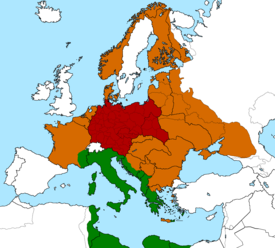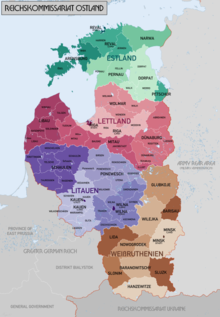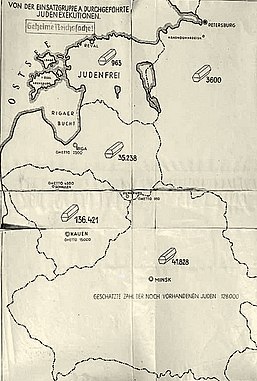Reichskommissariat Ostland
Reichskommissariat Ostland | |||||||||||||||||||||
|---|---|---|---|---|---|---|---|---|---|---|---|---|---|---|---|---|---|---|---|---|---|
| 1941–1945 | |||||||||||||||||||||
| Anthems: | |||||||||||||||||||||
 Reichskommissariat Ostland in 1942 | |||||||||||||||||||||
| Status | Reichskommissariat of Germany | ||||||||||||||||||||
| Capital | Riga | ||||||||||||||||||||
| Common languages | German (official) | ||||||||||||||||||||
| Religion |
| ||||||||||||||||||||
| Government | Colony of Nazi Germany | ||||||||||||||||||||
| Reichskommissar | |||||||||||||||||||||
• 1941–1944 | Hinrich Lohse | ||||||||||||||||||||
• 1944–1945 | Erich Koch | ||||||||||||||||||||
| Historical era | Baltic Operation | 22 June 1941 | |||||||||||||||||||
• Established | 17 July 1941 | ||||||||||||||||||||
• Implement civil administration | 25 July 1941 at 12:00 | ||||||||||||||||||||
| 5 December 1941 | |||||||||||||||||||||
| 1 April 1944 | |||||||||||||||||||||
• Soviet reoccupied Riga | 13 October 1944 | ||||||||||||||||||||
• Formally dissolved | 21 January 1945 | ||||||||||||||||||||
• Surrender of Courland Pocket | 10 May 1945 | ||||||||||||||||||||
| Currency | Reichskreditkassenscheine (de facto) | ||||||||||||||||||||
| |||||||||||||||||||||
| Today part of | Belarus Lithuania Latvia Estonia | ||||||||||||||||||||
The Reichskommissariat Ostland (RKO, "Reich Commissariat of Eastland"[b]) was established by Nazi Germany in 1941 during World War II. It became the civilian occupation regime in Lithuania, Latvia, Estonia, and the western part of Byelorussian SSR. German planning documents initially referred to an equivalent Reichskommissariat Baltenland.[1] The political organization for this territory – after an initial period of military administration before its establishment – involved a German civilian administration, nominally under the authority of the Reich Ministry for the Occupied Eastern Territories led by Nazi ideologist Alfred Rosenberg, but actually controlled by the Nazi official Hinrich Lohse, its appointed Reichskommissar.
Germany's main political objectives for the Reichskommissariat, as laid out by the Ministry within the framework of
In the course of 1943 and 1944, the Soviet Red Army gradually recaptured most of the Ostland territory in their advance westwards, but Wehrmacht forces held out in the Courland Pocket until May 1945. With the end of World War II in Europe and the defeat of Germany in 1945, the Reichskommissariat ceased to exist.
History
Planning before the attack on the Soviet Union

Originally the Reichsminister for the Occupied Eastern Territories (
After Operation Barbarossa
After the

Führer Decree of 17 July 1941 provided for this move. It established "Reichskommissariats" in the east, as administrative units of the Greater German Reich. The structure of each Reichskommissariat was defined by the same decree. Each of these territories would be led by a German civil governor known as a Reichskommissar appointed by Hitler and answerable only to him.[6] The official appointed for Ostland was Hinrich Lohse, the Oberpräsident and Gauleiter of Schleswig-Holstein. Local government in the Reichskommissariat was to be organized under a "National Director" (Reichskomissar) in Estonia, a "General Director" in Latvia, and a "General Adviser" in Lithuania.
Rosenberg's ministerial authority was, in practice, severely limited. The first reason was that many of the practicalities were determined elsewhere: the
In July 1941, the civil administration was declared in much of the occupied Soviet territories before one had materialised in the field. A power vacuum emerged which the SS filled with its SS and Police Leadership Structure, exercising unlimited power over security and policing which it gave up only grudgingly in the autumn when civil administration came into being; indeed Heinrich Himmler would use various tactics until as late as 1943 in unsuccessful efforts to regain this power. This partly explains the strained relations between the SS and the civil administration. In Ostland, matters were further complicated by the personality of the local superior SS officer Friedrich Jeckeln, attacked by the SS's opponents for his alleged corruption, brutality and mindless foolhardiness.
German plans
The short-term political objectives for Ostland differed from those for the
The regime planned to encourage the post-war settlement of
Historical German and Germanic-sounding placenames were also retained (or introduced) for many Baltic cities, such as Reval (Tallinn), Kauen (Kaunas), and Dünaburg (Daugavpils), among many others. To underscore the region's planned incorporation into Germany some Nazi ideologists further suggested the future use of the names Peipusland for Estonia and Dünaland for Latvia once they had become part of Germany.[10] The ancient Russian city of Novgorod, the easternmost foreign trading post of the Hanseatic League, was to be renamed Holmgard.[11] During the occupation, the Germans also published a "local" German-language newspaper, the Deutsche Zeitung im Ostland.
Administrative and territorial organization

The Reichskommissariat Ostland was sub-divided into four "General Regions" (Generalbezirke), namely Estonia, Latvia, Lithuania, and White Ruthenia (
Generalbezirk Estland (Estonia)
District seat: Reval (Tallinn)
Generalkommissar: Karl-Siegmund Litzmann
Subdivided into seven Kreisgebiete:
- Arensburg (Kuressaare)
- Narwa (Narva)
- Dorpat (Tartu)
- Pernau(Pärnu)
- Petschur (Petseri)
- Reval-Land (Tallinn-Rural)
- Reval-Stadt (Tallinn-Urban)
Generalbezirk Lettland (Latvia)
District seat: Riga
Generalkommissar: Otto-Heinrich Drechsler
Subdivided into six Kreisgebiete:
- Dünaburg (Daugavpils)
- Libau (Liepāja)
- Mitau (Jelgava)
- Riga-Land (Riga-Rural)
- Riga-Stadt (Riga-Urban)
- Wolmar (Valmiera)
Generalbezirk Litauen (Lithuania)
District seat: Kauen (Kaunas).
Generalkommissar:
(1944)
Subdivided into six Kreisgebiete:
- Kauen-Land (Kaunas-Rural).
- Kauen-Stadt (Kaunas-Urban).
- Ponewesch (Panevėžys).
- Schaulen (Šiauliai).
- Wilna-Land (Vilnius-Rural).
- Wilna-Stadt (Vilnius-Urban).
Generalbezirk Weißruthenien (White Ruthenia or Belarus)
Set up across the territory of the
District seat: Minsk.
Generalkommissar: Wilhelm Kube (1941–1943); Curt von Gottberg (1943–1944)
Subdivided into eleven Kreisgebiete:
- Baranowitsche(Baranovichi)
- Barisau(Barysau)
- Hanzewitschy (Hantsavichy)
- Lida
- Glubokoye (Hlybokaye)
- Minsk-Land (Minsk-Rural)
- Minsk-Stadt (Minsk-Urban)
- Nowogródek(Navahrudak)
- Slonim
- Sluzk (Sluck)
- Wilejka(Vileyka)
Other authorities
In March 1943, Wilhelm Kube succeeded in installing the Belarusian Central Council (a collaborationist puppet regime), which existed concurrently with the German civil administration.[14]
The military command was controlled by the Wehrmachtbefehlshaber Ostland ("Military Commander Ostland"). He was responsible for security within the occupied territories, to protect traffic connections and to record the harvest. These commanders were :
- Generalleutnant Walter Braemer (24 June 1941 - 18 April 1944)
- General der Panzertruppe Werner Kempf (1 May 1944 - 10 August 1944)
Policies
Upon taking control, Hinrich Lohse proclaimed the official decree ("Verkündungsblatt für das Ostland") on November 15, 1941, whereby all Soviet state and party properties in the Baltic area and Belarus were confiscated and transferred to the German administration.
In Ostland, the administration returned lands nationalised by the Soviets to the former peasant owners. In towns and cities, small workshops, industries and businesses were returned to their former owners, subject to promises to pay taxes and quotas to the authorities. Jewish properties were confiscated. In Belarus, a state enterprise was established to manage all former Soviet government properties. One of the German administrators was General commissar Wilhelm Kube.
Ostgesellschaften (state monopolies) and so-called Patenfirmen, private industrial companies linked to the German government, were quickly appointed to manage confiscated enterprises. The Hermann Göring Workshops,
In Belarus, the German authorities lamented the "Jewish-Bolshevik" policies that had allegedly denied the people knowledge of the basic concepts of private property, ownership, or personal initiative. Unlike the Baltic area, where the authorities saw that "during the war and the occupation's first stages, the population gave examples of sincere collaboration, a way for possibly giving some liberty to autonomous administration".
Economic exploitation
The Germans viewed the Slavs as a pool of slave work labor for use by the German Reich; if necessary they could be worked to death.
Extermination of the Jews in Ostland
At the time of the German invasion in June 1941 there were significant Jewish minorities in Ostland — nearly 480,000 people. To these were added deportees from Austria, Germany, and elsewhere.
Jews were confined to
The Soviet Red Army reported the discovery of Vilna and Kauen extermination centres as apparently part of the Nazi "Final Solution". The extermination of the resident Jews began almost immediately after the invasion and was later extended to the deportees.
In autumn 1943, the ghettos were "liquidated", and the remaining occupants were moved to camps at
Government figures
Aside from the German political leaders mentioned above, including Reich Minister Alfred Rosenberg, General Commissar Karl-Siegmund Litzmann and General Commissar Wilhelm Kube, the regional collaborationist structures across Reichskommissariat Ostland included Estonian political leaders such as Hjalmar Mäe, Oskar Angelus, Alfred Wendt (or Vendt), Otto Leesment, Hans Saar, Oskar Öpik, Arnold Radik, Johannes Soodla; Latvian political leaders with Oskars Dankers, and Rūdolfs Bangerskis; Lithuanian political leaders: Juozas Ambrazevičius, and Petras Kubiliūnas; as well as the Belarusian nationalist leaders from the Belarusian Central Council.
Partisan movement
German and local security authorities were kept busy by
, including the principal roads and railways in these areas.See also
- Belarus by Nazi Germany
Notes
- Das Lied der Deutschen, better known as Deutschland Über Alles.Tümmler 2010, p. 63.
- ^ "Ostland" may be translated less literally as Eastern Country or Eastern Territory, though Ostland has no real equivalence in the English language.
References
- ^
Alex J. Kay (2006). Guidelines for Special Fields (13 March 1941). Berghahn Books. p. 129. ISBN 1845451864. Retrieved 2013-06-25.)
In the week following [...] 2 May [1941], Alfred Rosenberg produced three papers relating to his preparations for the future administration in the occupied East. The first, dated 7 May, was entitled 'Instruction for a Reich Commissar in the Ukraine'. [...] The second, produced a day later, was its equivalent for the area of 'Baltenland', as the Baltic States and Belarus were at this stage being collectively referred to. In his drafting of the paper, Rosenberg crossed through 'Balten' and replaced it with 'Ost'. [...] The designation 'Ostland' would stick.
{{cite book}}:|work=ignored (help - ^ Pohl, Reinhard (November 1998). "Reichskommissariat Ostland: Schleswig-Holsteins Kolonie" [Reichskommissariat Ostland: Schleswig-Holstein's Colony] (PDF). Gegenwind. Gegenwind-Sonderheft: Schleswig-Holstein und die Verbrechen der Wehrmacht (in German). Gegenwind, Enough is Enough, and anderes lernen/Heinrich-Böll-Stiftung Schleswig-Holstein. pp. 10–12. Retrieved 2014-03-27.
Vom Einmarsch im Juni 1941 bis Ende Januar 1942, der Niederlage vor Moskau, töteten die deutschen Truppen im 'Ostland' etwa 330.000 Juden, 8359 "Kommunisten", 1044 "Partisanen" und 1644 "Geisteskranke". [...] Die erste Tötungswelle hatten ungefähr 670.000 Juden überlebt, dazu kamen im Winter 1941/42 noch 50.000 deportierte Juden aus dem Reichsgebiet, die in die Ghettos von Minsk und Riga kamen. [...] Anfang 1943 begann die zweite große Tötungswelle, der mindestens 570.000 Jüdinnen und Juden zum Opfer fielen. [...] Die letzten 100.000 Juden kamen in Konzentrationslager in Kauen, Riga-Kaiserwald, Klooga und Vaivara, sie wurden 1944 beim Heranrücken der Roten Armee liquidiert. [Translation: From the invasion in June 1941 until the end of January 1942 (the defeat at Moscow) German troops in 'Ostland' killed approximately 330,000 Jews, 8359 'Communists', 1044 'partisans' and 1644 'mentally ill' people. [...] About 670,000 Jews survived the first wave of killings, in the winter of 1941/1942 another 50,000 Jews deported from the Reich area joined these and ended up in the ghettos of Minsk and Riga. [...] At the beginning of 1943 the second great wave of killings began, in which at least 570,000 female and male Jews became victims. [...] The final 100,000 Jews entered the concentration camps in Kauen, Riga-Kaiserwald, Klooga and Vaivara; they were liquidated in 1944 with the advance of the Red Army.]
- ^ Czesław Madajczyk (Hrsg.): Vom Generalplan Ost zum Generalsiedlungsplan. Saur, München 1994, S. XI.
- )
- ^ Rich, Norman. (1973). Hitler's War Aims: the Nazi State and the Course of Expansion, page 217. W. W. Norton & Company Inc., New York.
- ^ Nazi Conspriracy and Aggression Volume 4. The Avalon Project. Decree of 17 July 1941.
- ISBN 1-84545-776-5
- ^ a b Rein 2010, p. 90-91
- ^ (Dutch) Werkman, Evert; De Keizer, Madelon; Van Setten, Gert Jan (1980). Dat kan ons niet gebeuren...: het dagelijkse leven in de Tweede Wereldoorlog, p. 146. De Bezige Bij.
- ^ Lumans, Valdus O. (2006). Latvia in World War II, p. 149. Fordham University Press.
- ^ a b Dallin, Alexander (1981). German rule in Russia, 1941-1945: a study of occupation policies. Westview. p. 185.
- ISBN 978-0-8179-2852-0.
- ^ (German) Dallin, Alexander (1958). Deutsche Herrschaft in Russland, 1941-1945: Eine Studie über Besatzungspolitik, p. 67. Droste Verlag GmbH, Düsseldorf.
- ^ a b Dallin (1958), pp. 234-236.
- ^ Jehke, Rolf. Territoriale Veränderungen in Deutschland und deutsch verwalteten Gebieten 1874 – 1945: Generalbezirk Weißruthenien. Herdecke. Last changed on 15 February 2010. Retrieved 13 June 2011.
- ISBN 0300095929.
Sources
- Arnold Toynbee, Veronica Toynbee, et al., Hitler's Europe (Spanish: La Europa de Hitler, Ed Vergara, Barcelona, 1958), Section VI: "Occupied lands and Satellite Countries in East Europe", Chapter II: "Ostland", p. 253-259 and footnotes.
- Ostland - Verwaltungskarte. Herg. vom Reichskommissar f. d. Ostland, Abt. II Raum. Stand der Grenzen vom 1. Nov. 1942 (map, in German)
- Tümmler, Holger (2010). Hitlers Deutschland: Die Mächtigen des Dritten Reiches (in German). Wolfenbüttel: Melchior Verlag. ISBN 978-3-941555-88-4.



